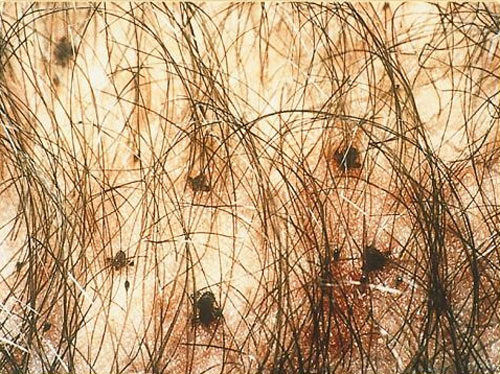Lice infestation (pediculosis) is a skin infestation by tiny wingless insects.
Lice are barely visible wingless insects that live by sucking blood. They spread easily from person to person by body contact and shared clothing and other personal items. Three species of lice inhabit different parts of the body.
Head lice infest the scalp hair. The infestation is spread by personal contact and possibly by shared combs, brushes, hats, and other personal items. Head lice are a common scourge of school children of all social strata. Head lice are less common among blacks. There is no association between head lice and poor hygiene or low socioeconomic status.
Body lice usually infest people who have poor hygiene and those living in close quarters or crowded institutions. They live in the seams of garments that are in contact with the skin. Body lice are spread by sharing contaminated clothing and bedding. Unlike head lice, body lice sometimes transmit serious diseases such as typhus, trench fever, and relapsing fever.
Pubic lice (“crabs”), which primarily infest the genital area, are typically spread during sexual contact. These lice may infest the chest hair, underarm hair, beard hair, eyebrows, and eyelashes as well.
Symptoms and Diagnosis
Lice infestation usually causes severe itching in the infested area. Intense scratching often breaks the skin, which can lead to bacterial infections. Children may hardly notice head lice or may have only a vague scalp irritation.
Head lice can be found by moving a fine-tooth detection comb through wet hair from the scalp outward. Lice themselves are sometimes hard to find, but their eggs are easier to see. Female lice lay shiny grayish white eggs (nits) that can be seen as tiny globules firmly stuck to hairs near their base. With chronic scalp infestations, the nits grow out with the hair and therefore can be found some distance from the scalp, depending on the duration of the infestation.
Nits are distinguished from other foreign material present on hair shafts by the fact that they are so strongly attached. Adult body lice and their eggs also may be found in the seams of clothing worn close to the skin. Public lice can be found by close inspection.
Treatment
Several effective prescription and nonprescription drugs are available to treat lice. Nonprescription shampoos and creams containing pyrethrins plus piperonyl butoxide are applied for 10 minutes and are then rinsed out. Prescription permethrin Some Trade Names
NIX
(a synthetic form of pyrethrin), applied as a liquid or as a cream, is also effective. Lindane—a prescription drug that can be applied as a lotion or shampoo—also cures lice infestation but is not as effective as the other preparations and is not recommended for young children because of possible neurologic side effects. Prescription malathion Some Trade Names
OVIDE
is highly effective at killing both adult lice and eggs, but it is not considered a first line of treatment because it is flammable, has an unpleasant odor, and must remain on the skin for 8 to 12 hours. All louse treatments are repeated in 7 to 10 days to kill newly hatched lice. Lice have started to become resistant to drugs and may be hard to kill. One dose of the drug ivermectin Some Trade Names
STROMECTOL
is usually given by mouth if lice resist standard treatment.
Most drug treatments also kill nits but do not remove them. Dead nits do not have to be removed, but drugs do not always kill all nits. Because it is not possible to distinguish between living and dead nits, doctors recommend removing them. Nonetheless, a very small percentage of children with nits in their scalp actually have live lice. Removal requires a fine-tooth comb—which is often packaged with the medication—and careful searching (hence the term “nit-picking”). Because the nits are so strongly stuck to the hair, several nonprescription preparations are available to loosen them. Nits are carried away from the scalp as the hair grows. If there are no nits within 1/4 inch of the scalp, the person does not have any live lice. The nits of body lice are destroyed simply by throwing away infested clothing or decontaminating it by thorough laundering or dry cleaning. For head lice, doctors do not have good evidence whether it is necessary to clean or throw away people's personal items or to exclude people from school or work.
















































No comments:
Post a Comment